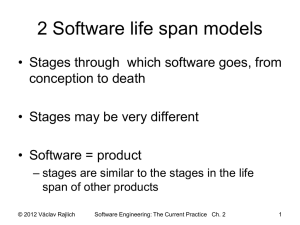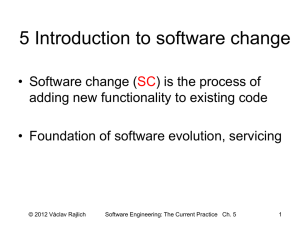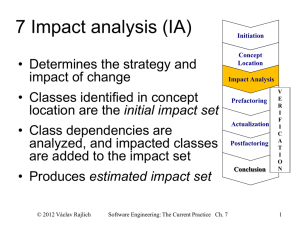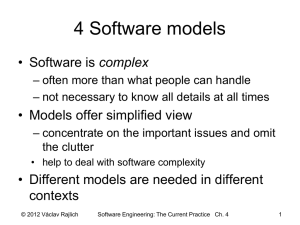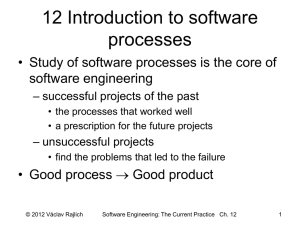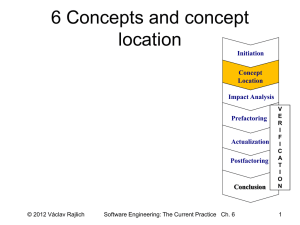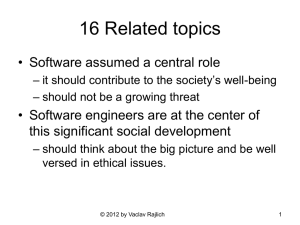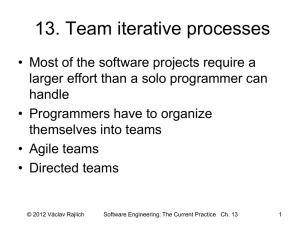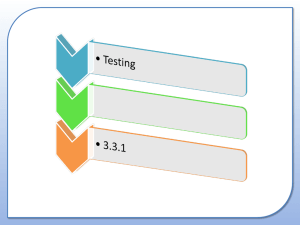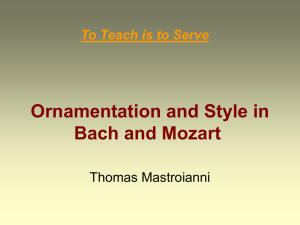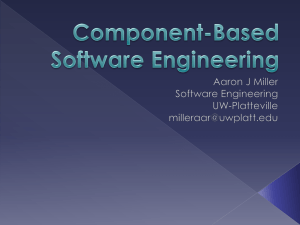10 verification
advertisement
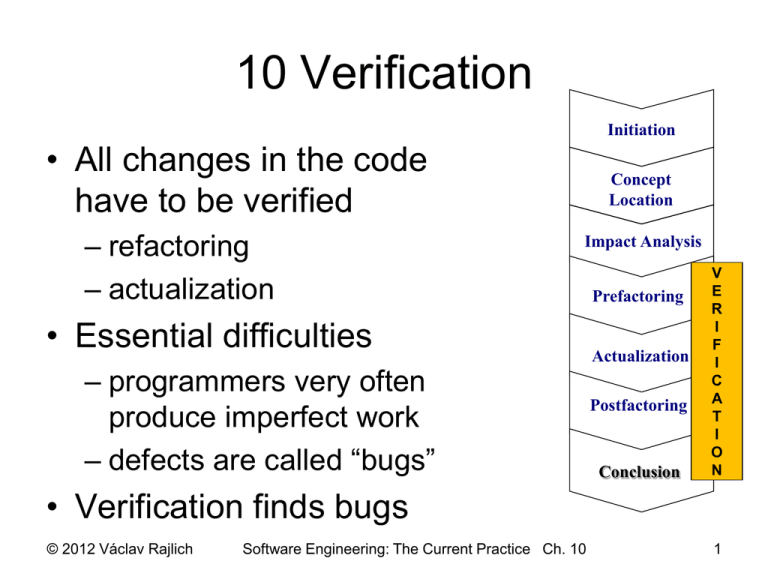
10 Verification
Initiation
• All changes in the code
have to be verified
– refactoring
– actualization
Concept
Location
Impact Analysis
• Essential difficulties
– programmers very often
produce imperfect work
– defects are called “bugs”
Prefactoring
Actualization
Postfactoring
Conclusion
V
E
R
I
F
I
C
A
T
I
O
N
• Verification finds bugs
© 2012 Václav Rajlich
Software Engineering: The Current Practice Ch. 10
1
Verification techniques
• Many techniques of software verification
have been researched and proposed
• Current practice
– testing
– code inspection
© 2012 Václav Rajlich
Software Engineering: The Current Practice Ch. 10
2
Testing
• Tests execute the program or its parts
– specific input to the execution
– compare the outputs of the execution with the
previously specified outputs
– report if there is a deviation
• Tests are usually organized into a test
suite
– several, often many, tests.
© 2012 Václav Rajlich
Software Engineering: The Current Practice Ch. 10
3
Incompleteness of the testing
• “Testing can demonstrate the presence of
the bugs, but not their absence. “
• No matter how much testing has been
done, residual bugs still can hide in the
code
– they have not been revealed by any tests
– no test suite can guarantee that the program
runs without errors
© 2012 Václav Rajlich
Software Engineering: The Current Practice Ch. 10
4
Turing’s halting problem
• Theoretical reason for testing
incompleteness
• It is theoretically impossible to create a
perfect test suite
• The programmers have been trying to do
the best under the circumstances
– techniques of the testing cannot guarantee a
complete correctness of software
– well designed tests come close to be adequate
© 2012 Václav Rajlich
Software Engineering: The Current Practice Ch. 10
5
New vs. old code tests
• Tests of the new code
– new tests must be written with the new code
• Testing of the old code
– the tests make sure the old code is not broken
by the change
– regression tests
– prevent regression of what was already
functioning in the software.
– Merriam Webster: “regression” = “a trend or shift toward
a lower or less perfect state”
© 2012 Václav Rajlich
Software Engineering: The Current Practice Ch. 10
6
Variety of software testing
• Setting
– programmer’s workspace
– team’s configuration management
• Strategy
– structural
– unit
– functional
• Functionality
– old (regression testing)
– new
– Combined (system testing)
© 2012 Václav Rajlich
Software Engineering: The Current Practice Ch. 10
7
Acceptance tests
• Final functional test
– both the new and the old functionality
• Done during the phase of change
conclusion
– test the complete functionality of the software
– software stakeholders are able to asses the
progress of the software project
© 2012 Václav Rajlich
Software Engineering: The Current Practice Ch. 10
8
Composition of the test suite
• Unit tests
– test for a specific class
• Functional tests
– test a specific functionality of the whole program
• user manual or graphics user interface guide the
creation of the functional tests.
• all features that are available to the user should be
tested
• Structural tests
© 2012 Václav Rajlich
Software Engineering: The Current Practice Ch. 10
9
Harness (scaffolding)
• Test drivers
– implement the support for the tests
• Stubs
– implement the replacement for missing classes and
subsystems
• Environment simulation
• Harness = drivers + stubs + simulators
– production code vs. harness
– developers vs. testers
© 2012 Václav Rajlich
Software Engineering: The Current Practice Ch. 10
10
Harness and production code
• Production code goes to the user
• Harness stays within the programming
group
• Parallel evolution of both
code 1
code 2
code 3
harness 1
harness 2
harness 3
© 2012 Václav Rajlich
Software Engineering: The Current Practice Ch. 10
11
Coverage
• We cannot guarantee a complete
correctness of the code by testing
• We are going to guarantee that each unit
of the tested code is executed at least
once
– this guarantees that at least some of the bugs
are discovered
• in particular, the bugs that are brought up by this
single execution of the unit.
© 2012 Václav Rajlich
Software Engineering: The Current Practice Ch. 10
12
Granularity of methods
• calcSubTotal(), calcTotal(), getPrice(),
setPrice(double)
– each of them executed at least once
• Seems like a crude approach
– systematic
– guarantees correctness better than random
selection of tests
© 2012 Václav Rajlich
Software Engineering: The Current Practice Ch. 10
13
Statement coverage
• Guarantees that every statement of the
program is executes at least once
• Minimal test suite does not have any
redundant tests
– tests that cover only statements that are
already covered by other tests
• Minimal test suite efficiently accomplishes
the coverage
– preferred approach
© 2012 Václav Rajlich
Software Engineering: The Current Practice Ch. 10
14
Example
read (x); read (y);
{<x =2, y =3>}
– incomplete coverage
if x > 0 then write ("1");
– does not cover write (“2”)
else write ("2");
{<x =2, y = 3>,<x =9,y =1>,
end if;
<x =0,y =0>}
if y > 0 then write ("3");
– complete coverage
else write ("4");
– not minimal
end if;
– <x =9, y=1> is redundant
{<x =2, y= 3>, <x =0,y =0>}
– complete and minimal
© 2012 Václav Rajlich
Software Engineering: The Current Practice Ch. 10
15
Minimal complete test suite
• Easy to write the first test
– no matter what it covers, it adds to the test
suite coverage
• Increased number of tests
– the statements not covered are fewer
– it is increasingly hard to aim new tests at
these remaining uncovered statements
– increased coverage may not be economic
• 70% coverage is considered to be good
© 2012 Václav Rajlich
Software Engineering: The Current Practice Ch. 10
16
Unit testing
• Testing of individual modules
– testing classes and methods
• Testing of the composite functionality
– the class is being tested together will all
classes that support it
• Testing local functionality
© 2012 Václav Rajlich
Software Engineering: The Current Practice Ch. 10
17
Testing driver
Driver
+test()
Item
+calcSubTotal() : double
+calcTotal() : double
Price
+getPrice() : double
+setPrice() : double
© 2012 Václav Rajlich
Software Engineering: The Current Practice Ch. 10
18
Testing driver example
public class TestItem {
Item testItem;
public void testCalcSubTotal() {
assert(testItem.calcSubTotal(2, 3) == 6);
assert(testItem.calcSubTotal(10, 20)==30);
}
public void testCalcTotal() {
assert(testItem.calcTotal(0, 5) == 5);
assert(testItem.calcTotal(15, 25) == 40);
}
} ;
© 2012 Václav Rajlich
Software Engineering: The Current Practice Ch. 10
19
Testing local responsibility
• Driver + stub
– stub simulates suppliers
• part of harness
• Reasons: supplier classes
– are not available
– have not been tested
• the confidence in them is low
– support a limited contract (limited precondition)
• the tested class to be used with other suppliers
© 2012 Václav Rajlich
Software Engineering: The Current Practice Ch. 10
20
Stubbing techniques
• Less effective algorithm
– easier to implement
– test becomes less efficient
• developers do testing, acceptable impact
• Limited precondition of the stub
– simplifies the code of the stub substantially
• convert the date into a day of the week
– the stub does that only for a selected month
• inappropriate if the stubbing reason is to broaden
the contract
© 2012 Václav Rajlich
Software Engineering: The Current Practice Ch. 10
21
Stubbing techniques, cont.
• User intervention
– interrupts the test, the user provides the
correct answer
• practical only in if the stub is executed only few
times during the test
• human user may input incorrect values
• Replacement contract
– quick but incorrect postcondition
– the most controversial stubbing technique
– still may provide valuable results
© 2012 Václav Rajlich
Software Engineering: The Current Practice Ch. 10
22
Functional testing
• Tests the functionality of the complete
program
• Program with GUI: test every function
– “tape recording” for future tests
• Coverage
– percentage of the requirements tested
© 2012 Václav Rajlich
Software Engineering: The Current Practice Ch. 10
23
Regression Testing
• After change, programmers retest the code
– reestablish the confidence that the old
functionalities of the software still work
– change may have inadvertently introduced stray
bugs into the intact parts
• Tests from the past constitute the bulk of the
regression test suite
– test suite often grows
– testing is often done overnight
© 2012 Václav Rajlich
Software Engineering: The Current Practice Ch. 10
24
Test suite evolution
delete obsolete tests
regression test
system test
add tests of new functionality
© 2012 Václav Rajlich
Software Engineering: The Current Practice Ch. 10
25
Obsolete tests
• Broken test cases that cannot run
– they do not interface with the software any more
• Tests that do not fulfill their purpose
– a test case testing the limits of a range becomes
obsolete when the range is changed
• Tests that no longer provide a
deterministic result
– a test case which may now impacted by the mouse
© 2012 Václav Rajlich
Software Engineering: The Current Practice Ch. 10
26
Code inspection
• Somebody else than the author reads the
code
– checks its correctness
– reports bugs
• Code inspection does not require
execution of a system
– can be applied to incomplete code or to other
artifacts
• models, documentation
© 2012 Václav Rajlich
Software Engineering: The Current Practice Ch. 10
27
Effectiveness of code inspection
• “Habituation”
– people become blind to their own mistakes
• After reading the code several times
– programmers no longer read the code
• recall from the memory what the code should
contain
• some errors repeatedly escape their attention
– a different reader spots these errors easily
and right away
© 2012 Václav Rajlich
Software Engineering: The Current Practice Ch. 10
28
Inspections and testing are
complementary
• Some bugs are easily found by testing
– they appear in each test
• they are sometimes hard to spot by human
• example: misspellings of long identifiers
• Some bugs are hard to find by testing
– it is hard to create a test that finds them
• human readers can find them easily
• example: a possible division by zero
• to create a test that causes such situation can be
hard
© 2012 Václav Rajlich
Software Engineering: The Current Practice Ch. 10
29
Inspection of different artifacts
• Inspections can also check whether
different artifacts agree with each other
– does the code correspond to the change
request?
– does the UML model correspond to the actual
code?
• Inspections cannot check non-functional
characteristics
– performance and usability
© 2012 Václav Rajlich
Software Engineering: The Current Practice Ch. 10
30
Walkthroughs
• Structured inspection process
• Walkthrough team
– at least four members
• the author of the inspected code
• a moderator
• at least two code reviewers.
© 2012 Václav Rajlich
Software Engineering: The Current Practice Ch. 10
31
Walkthrough process
• Preparation
– the code or other work products are
distributed to inspection team
– one participant (reader) is selected to inspect
the document thoroughly
• Walkthrough meeting
– all team members participate
– whole group walks through the document
under direction of the reader
© 2012 Václav Rajlich
Software Engineering: The Current Practice Ch. 10
32
Walkthrough meeting
• The reader notes the errors, omissions
and inconsistencies in the code
– the other members of the team add their own
observations
• The moderator chairs the meeting
– notes the discovered errors
– produces a report
• recommendations, which documents have to be
corrected or reworked
© 2012 Václav Rajlich
Software Engineering: The Current Practice Ch. 10
33
